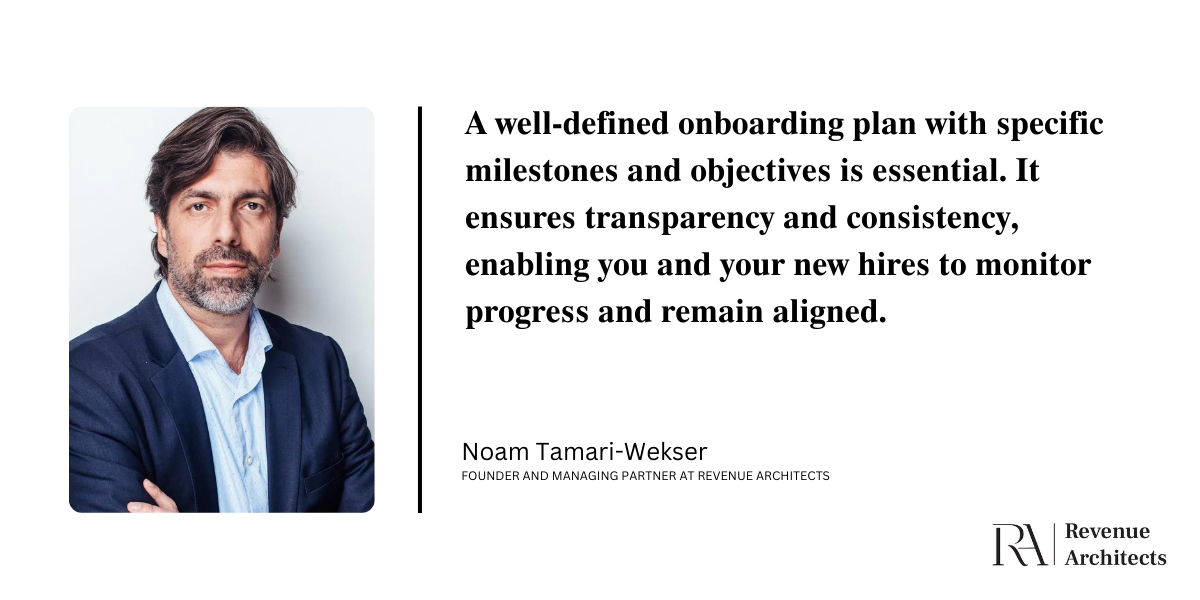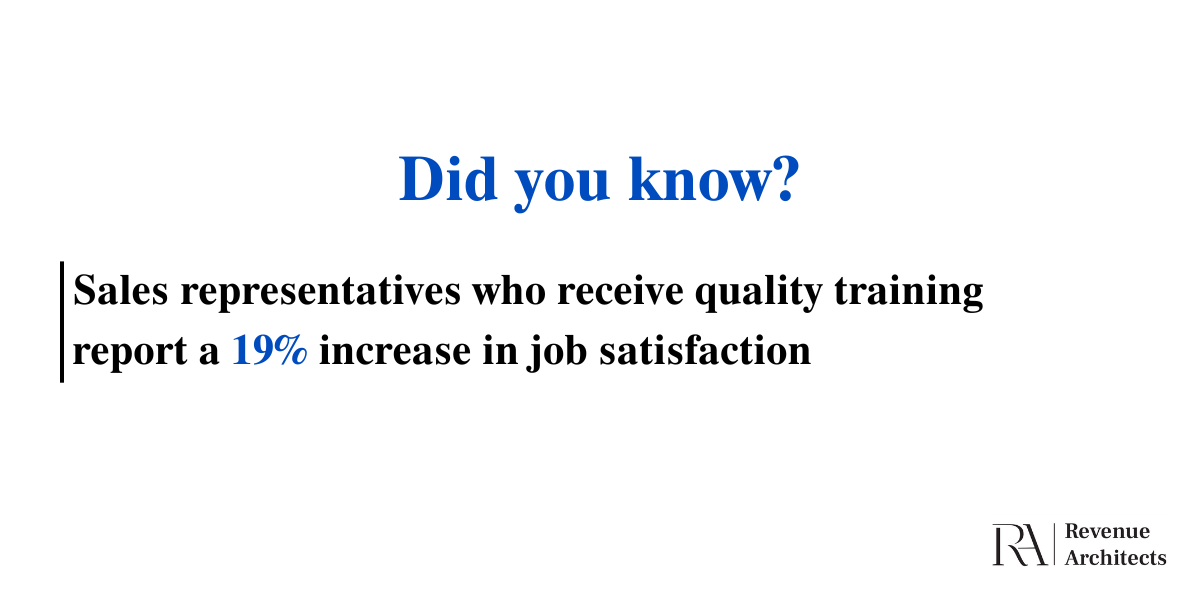Sales Development Representatives (SDRs) are not just another role in the sales organization, they are the backbone of its success. They are the front line, responsible for identifying potential clients, generating leads, and feeding qualified prospects into the sales funnel. The journey from hiring an SDR to turning them into a productive sales team member is complex and requires a well-structured onboarding and ramp-up process. This article will show you how to ramp up and onboard SDRs, ensuring they hit the ground running and contribute to your team’s success as quickly as possible. As an additional bonus, you will receive hands-on advice from one of our top sales coaches, Noam Tamari-Wekser.
Understanding the Importance of SDR Onboarding and Ramp-Up
Onboarding and ramping SDRs is more than just familiarizing them with the company’s products or services. It’s about equipping them with the skills, knowledge, and confidence they need to excel in their role and grow both personally and professionally. A well-structured onboarding process can significantly reduce the time it takes for an SDR to become fully productive. It will also minimize turnover and improve the overall performance of your sales team.
Conversely, a poorly managed onboarding process can lead to serious consequences such as frustration, low morale, and high turnover rates. According to industry studies, it takes an average of three to six months for a new SDR to reach total productivity. Therefore, a thoughtful and deliberate approach to onboarding is not just beneficial but crucial for the success of your sales team.
Crafting a Detailed Onboarding Plan
A successful SDR onboarding program is not a vague concept but a clear and detailed plan that covers the first few weeks or months of the new hire’s journey. This plan should be divided into phases, each with specific goals and milestones, providing a roadmap for the new SDR’s journey to success.

Below is our example of an onboarding plan.
Pre-Onboarding Preparation: Preparation is vital before the new SDR even steps into the office (or logs in remotely). Ensure all the necessary tools, resources, and accounts are set up. This includes CRM access, email accounts, and any software they must use. Having these ready from day one helps the new SDR focus on learning rather than administrative tasks.
Week 1
Orientation and Introduction
The first week should focus on helping the new SDR acclimate to the company culture and understand how their role fits into the organization. This phase includes:
Company Overview: Introduce the company’s history, mission, values, and goals.
Product/Service Training: Provide a high-level overview of the company’s products or services. This should include understanding the value proposition and key differentiators.
Team Introductions: Schedule meetings with key team members, including sales leaders, marketing teams, and other SDRs. Building these relationships early on can foster a sense of belonging and support.
Weeks 2-4
Deep Dive into Tools and Processes
The next phase involves immersing the SDR in the tools, processes, and strategies they will use daily. This includes:
CRM Training: Provide comprehensive training on the CRM system. Ensure they log activities, manage their pipeline, and track their progress.
Sales Process Familiarization: Walk them through the sales process from lead generation to deal closure. Explain the roles of different team members in this process.
Outbound Techniques: Teach them the various outbound techniques they will use, such as cold calling, email outreach, and social selling.
Advice from Noam:
“Begin with basic tools and progressively introduce more advanced ones, ensuring that reps are comfortable at each stage before moving forward. Granting reps increased freedom with messaging during the ramp-up phase fosters creativity and effective personalization, both of which are crucial for successful selling.”
Weeks 5-8
Hands-on practice and Role-Playing
Learning by doing is crucial in this phase. The new SDR should start practicing what they’ve learned through role-playing and shadowing experienced SDRs.
Call Scripts and Objection Handling: Provide them with call scripts and train them on handling common objections. Role-playing scenarios can be incredibly beneficial here.
Shadowing: Allow the new SDR to listen in on calls from seasoned reps. This gives them real-world insights into how conversations flow and how to navigate challenges.

Month 2-3
Gradual Increase in Responsibilities
As the new SDR becomes more comfortable, gradually increase their responsibilities. Start with more manageable tasks and progressively introduce more challenging ones.
Initial Outreach: Begin with simple outreach tasks, such as following up on warm leads or handling inbound inquiries.
Personalized Outreach Strategies: As they gain confidence, they can create and execute customized outreach strategies, such as crafting tailored emails or developing specific calling plans for different target segments.
Month 3-4
Full Autonomy and Continuous Improvement
By the end of the third month, the new SDR should be ready to take on their full responsibilities. However, the learning continues. Continuous feedback and improvement are essential.
Bonus tips:
- Don’t forget performance Reviews: Conduct regular performance reviews to assess their progress and provide constructive feedback.
- Advanced Training: Offer opportunities for advanced training in data analysis, customer relationship management, or advanced sales techniques.
Critical Strategies for Effective SDR Ramp-Up
While the onboarding plan is essential, specific strategies can further enhance the effectiveness of your ramp-up process. Here are some of the most effective tactics that we love implementing:
Set Clear Expectations Early On
From the beginning, ensure the new SDR understands what is expected of them. This includes daily, weekly, and monthly targets and qualitative expectations like the quality of their outreach efforts and adherence to the sales process.

Provide Continuous Coaching and Feedback
Ongoing coaching is critical to the success of any SDR. This should include more than formal performance reviews but regular, informal check-ins. Please provide feedback on their calls, emails, and overall approach. Positive reinforcement for what they are doing right is just as necessary as constructive criticism.
Leverage Technology and Automation
Utilize technology to streamline the onboarding process. Automated onboarding checklists, CRM-integrated training modules, and AI-driven coaching tools can help new SDRs learn faster and more effectively. Automation can also help track their progress and identify areas needing additional support.
Encourage Peer Learning and Mentorship
Pairing new SDRs with experienced mentors can accelerate their learning. Encourage them to observe and learn from their peers. Peer learning groups, where SDRs can share experiences and best practices, can also be highly beneficial.
Focus on Soft Skills Development
While product knowledge and sales techniques are critical, soft skills are equally important. Communication, active listening, and empathy are vital for building prospective relationships. Include soft skills training in your onboarding program to ensure your SDRs are well-rounded professionals.
Celebrate Early Wins
Recognize and celebrate early successes, no matter how small. This boosts the new SDR’s confidence and reinforces positive behaviors. It also helps them feel like a valuable part of the team from the start.
Implement a Gradual Transition to Full Quota
Rather than expecting new SDRs to meet total quota targets immediately, consider a gradual ramp-up to full quota over a few months. This approach allows them to build their skills and confidence without the pressure of hitting total targets immediately.
Foster a Culture of Continuous Learning
Sales is an ever-evolving field, and your SDRs should be encouraged to keep learning. Provide access to ongoing training through online courses, workshops, or internal knowledge-sharing sessions. A culture that values continuous learning will keep your SDRs engaged and motivated.
Measuring the Success of Your Onboarding Program
To ensure that your ramp-up program is effective, measuring its success is essential.
Here are some key metrics to track:
1. Time to Productivity: How long does it take for new SDRs to reach total productivity? This includes the time it takes to achieve quota and qualitative measures like call quality and lead conversion rates.
2. Retention Rates: High turnover among new hires can signify a flawed onboarding process. Track retention rates to see how many new SDRs stay with the company beyond the first few months.
3. Performance Metrics: Compare the performance of new SDRs with that of more experienced reps. This includes metrics like the number of calls made, emails sent, meetings booked, and deals closed.
4. Feedback from SDRs: Solicit input from the SDRs themselves about the onboarding process. Their insights can help you identify areas for improvement and refine your program.
5. Managerial Assessments: Regularly assess the onboarding process with input from sales managers. They can provide valuable feedback on how well the new SDRs integrate into the team and contribute to overall sales goals.
If you need more information on calculating your sales ramp-up period effectively, we wrote another article just about that topic.
In Conclusion
Getting your SDRs ramped up and ready to hit the ground running is no easy feat, but with the right onboarding plan and support, it can make a huge difference in your sales team’s success. In fact, 81% of companies say productivity would improve with better processes, skills, or competency training. By focusing on solid training, ongoing development, and clear performance goals, you’re setting your SDRs up to thrive, not just survive.
If you’re looking for a little extra help to streamline your SDR ramp-up process, our team’s got you covered. We can work with you to build a plan that gets your reps up to speed faster and keeps them performing at their best. Reach out to us and let’s chat about how we can help you build a rockstar SDR team.

